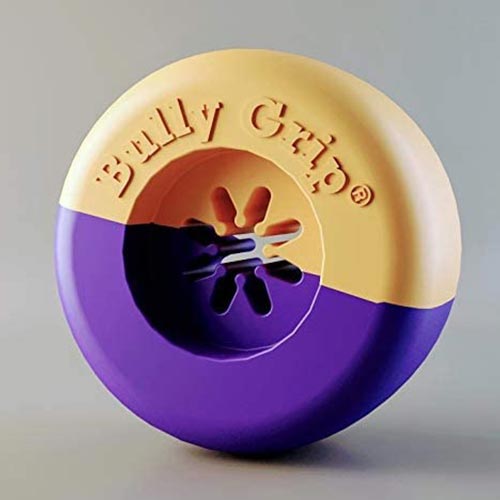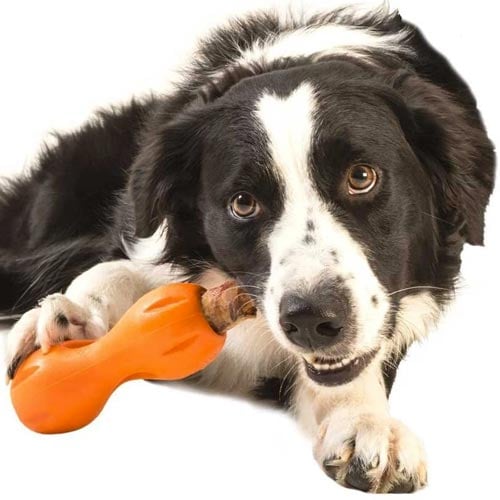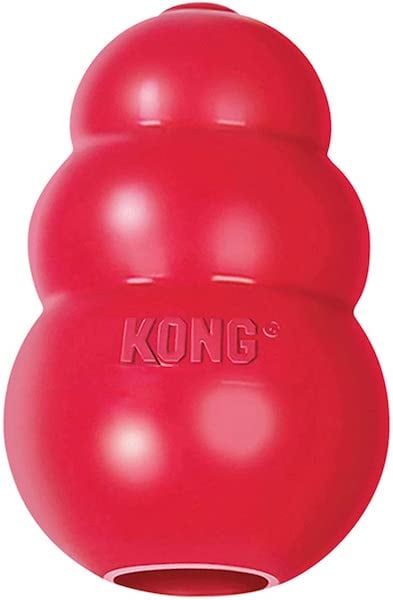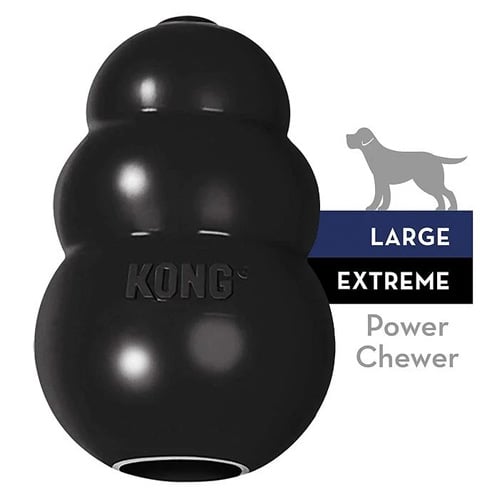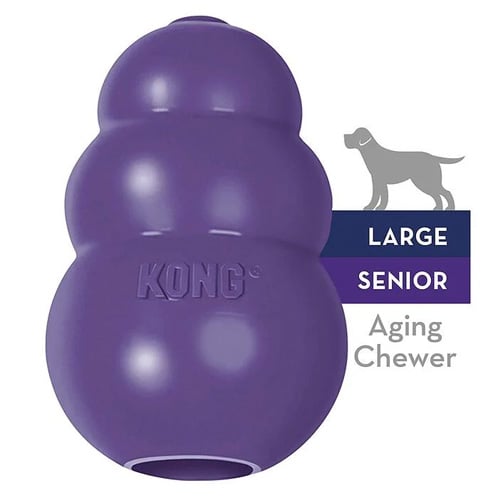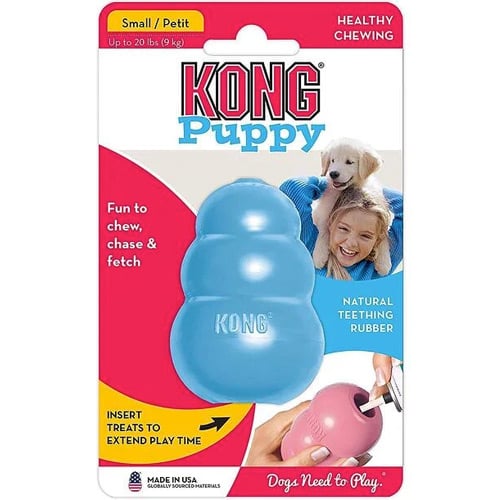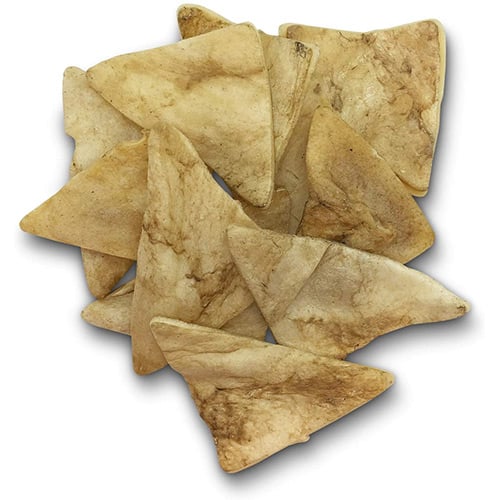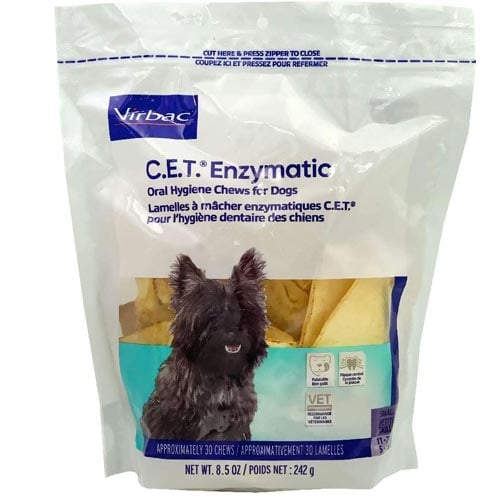 Dogs have an innate desire and need to chew. It is their way to search out the world that surrounds them.
Dogs have an innate desire and need to chew. It is their way to search out the world that surrounds them.
Chewing helps dogs accomplish several things. For puppies that are teething, like for babies, chewing helps relieve pain.
Older dogs may chew to keep their jaws strong and their teeth clean. Some dogs chew for the simple fun of it.
But chewing can also be a way for dogs to work through and relieve anxiety, frustration, or boredom.
Unfortunately, they’re not always great at picking the best things to chew on. This is where you come in.
As with everything else, it can sometimes feel like there are as many types of chews and chew toys as there are dogs to chew them. Based on experience, good or bad, everyone has a personal pick for their dog.
With anything in our dog’s world — and ours, for that matter — there is always something potentially dangerous about everything.
My entire life and throughout my career as a veterinarian, I was always taught to share both my good and bad experiences as well as my knowledge. Being aware of these potential dangers and risks can empower others to make choices that best suit their dog and their lifestyle.
There are some types of chews and chew toys that are best avoided if you want to keep your dog safe or at least lessen your risk of veterinary emergencies or dental costs. Even if you decide that you still want to give your dog the following chews and toys, it is always important to be aware of the dangers and risks with regard to your dog. I have always liked the saying, “Forewarned is forearmed.”
The dog chews I review in this article are very popular. And even though they all have potential health hazards, they’re found in many pet retailers and online. The pet industry isn’t highly regulated, and many treats, toys, and chews aren’t formulated with or by veterinarians or take veterinary insights into account.
While I realize many dog owners understandably argue that their dogs have never had problems before with these types of chews or that they’ve never heard of dogs having any problems with a particular chew. The keywords here are “before” and “haven’t heard.” Every dog is an individual, and life can change in an instant — bad incidents can change things forever.
That’s not to say that every dog will have a problem with these chews, but many dogs can have a problem.
Chews and Chew Toys You Should Not Give Your Dog
Remember, different strokes for different folks! I’ll willingly acknowledge that not every dog will have a problem with these toys. But I feel it would be inappropriate if I didn’t at least discuss with you the risks.
Then you can decide what is best for you and your dog. The likelihood of moderate-to-severe issues is much higher if a dog is allowed to chew on the following objects and products.
Primary Safety Factors When Evaluating Dog Chews
The primary things I look for when evaluating the safety of dog chews are:
- Hardness – If the chew is harder than the teeth, there’s a probability of causing tooth injuries.
- Obstruction risk in the gastrointestinal tract – The risk of chunks that are indigestible coming off and being swallowed.
- Choking hazard – Same as above, but in this case, the chucks get lodged in the trachea or esophagus and don’t make it to the stomach or intestines.
As vets, we see first-hand the problems, from cracked teeth to digestive obstruction and even death, that can result from dogs who are injured by something as seemingly innocent as a chew toy.
For more insight into picking an appropriate chew toy for the type of chewer your dog is, check out our article How to Choose Safe Dog Chews.
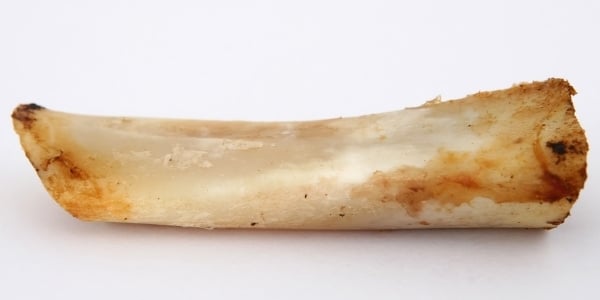
Bones
Now here’s a rather controversial topic … but let’s go there! Spend enough time online, and you’ll find plenty of blogs and sites that say it’s OK to give bones to your dog, so long as they’re uncooked and of a specific type.
(Thankfully, pretty much everyone agrees that cooked chicken, turkey, rib, and other “brittle” bones aren’t safe as they easily splinter and cause digestive upset or puncture).
On the one hand, some people will wholeheartedly recommend bones, claiming that uncooked, solid bones (like beef knuckle bones, etc.) can provide hours of safe and natural chewing.
They often cite the “naturalness” of dogs chewing on bones since wolves and dogs in the wild will eat or chew through bones. That’s partially true, but only if you ignore these other facts about bones:
Bones Splinter
Whether cooked, uncooked, solid, or hollow, bones can and do splinter, and they're still hard enough to break teeth.
A client brought their big tough German Shepherd mix to the clinic because he was screaming when he attempted to poop.
To my surprise, when I did his rectal exam, there were two almost two-inch-long bone splinters stabbing into either side of his anal sphincter (ouch!).
Following removal, he pooped a lot of watery stool filled with a lot more bone fragments — which, if left unaddressed, likely would have created a blockage.
Bones Can Lead to Constipation
Bone fragments can make it all the way through the small intestines only to collect in the colon and cause constipation.
A client presented an older farm dog that he noticed wasn’t eating or acting normally. He did note that he hadn’t noticed her pooping for about a week.
When we radiographed her abdomen, her colon was completely blocked by bones. I am happy to say that after a very long process (over two hours) and the worst smelling substance you can imagine, we successfully cleared the blockage and she went home a happy dog. Sadly, that isn’t always the case.
Bones Can Cause Dogs to Choke
If a piece of bone breaks off, it can lodge in the esophagus on the way down to the stomach. Shards of bone can pierce the throat or esophagus. Once lodged there, the area can swell, making breathing difficult.
I had a beautiful and sweet pitbull come in because she wasn’t eating or breathing normally after a visitor to the home gave her a bone several hours prior.
She allowed me to open her mouth wide and the bone was wedged sideways far back in her throat. Following sedation and removal, we realized the bone was actually quite large but due to all the soft tissue swelling and the piercing into the surrounding soft tissue, we couldn’t tell from the initial evaluation.
Had the owners delayed much longer she would have had her airway blocked off and likely have passed away.
Even the FDA has issued a warning to pet owners about bones and provided a bulletin of reasons. The above are only just a few stories of my negative experiences with bones as chews for dogs, and fortunately, they had good endings. But that isn’t always the case.
Since I have seen the damage and devastation that chewing bones can cause, I will never recommend bones, whether cooked or raw, as a chew toy for dogs, and I will always warn against them.
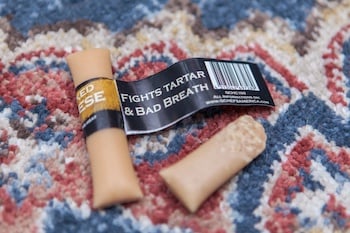
Hard Cheese Chews, Yak Chews, and Blocks
Aside from perhaps some lactose intolerance, cheese shouldn’t pose too much of a problem for dogs, right? Well, when it’s been processed into a rock-hard “block” or “bone,” it certainly can.
Cheese blocks and cheese bones, including yak cheese treats, can be much too hard for regular chewing and can lead to broken teeth for an unfortunate dog. In my own test, the Ecokind Yak Cheese Chews did not pass the "thumbnail test" (a good chew should be soft enough that it will give if you press it with your thumbnail).
If you want to give your dog cheese, stick to small amounts of the real stuff like string cheese. For a less stinky option in your treat pouch, opt for the freeze-dried cheese treats, which can make for a great high-value treat during training.
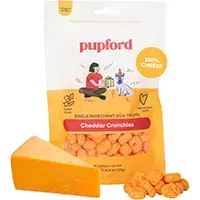
If you still want to give your dog these hard cheese chews, you can attempt to warm them in the microwave to soften them. However, the brands I tried during my testing didn't become any softer.
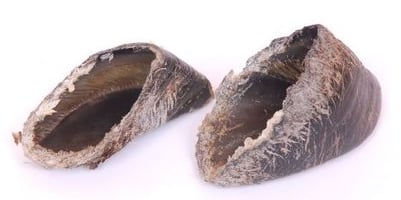
Cow Hooves
Cow hooves used to be all the rage for dog chews — fortunately, they seem to have gone out of favor. Of course, you can still find them quite easily.
Like bones and other hard chew toys, cow hooves pose the dual danger of breaking your dog’s teeth or splintering, which could lead to puncture injuries of your dog’s mouth or digestive tract.
Since they are circular-shaped, they can get looped around the lower jaw, just behind the lower canine teeth. As you can imagine, this causes most dogs to panic. Unfortunately, this often requires your dog to be sedated by their veterinarian in order to have the hoof cut off of their jaw.
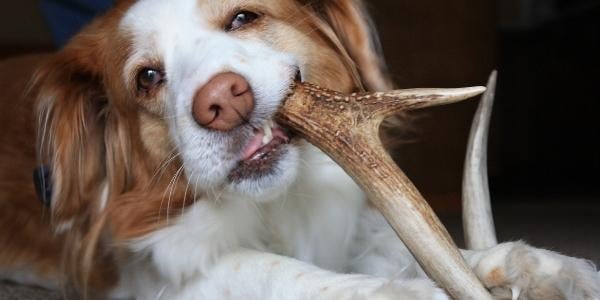
Elk or Deer Antlers
Antlers tend to top the list of super popular dog chews. Pet owners often view them as natural and “sustainably harvested” (elk and deer shed their antlers naturally). Have you ever seen bucks or bull elk fight? It is intense, to say the least.
- Antlers are hard enough to withstand the force of another deer’s antlers in battle, which means they’re definitely hard enough to break your dog’s teeth.
- Like bones, antlers can break and splinter. These splinters can get lodged in your dog’s mouth, throat, or intestines.
Even dedicated antler users confess that there are different grades of antlers. They discuss how these lower grades can pose hazards to dogs. Generally, they only support Grade A antlers due to the fact they were "softer" and fresher.
They always say things come in threes. I was thankful one week when they only came in two when two pets presented almost back to back with slab fractures of the premolar due to chewing on antlers.
Besides the damage to the teeth, antlers can cause significant trauma to the gums which can result in pain and bleeding.
They can also be sharp enough to cause oral puncture injuries. In fact, the antler fad has caused enough injuries that many veterinarians and board-certified veterinary dentists have begun issuing warnings to help pets avoid the pain, and for their owners to avoid the costs of antler-related injuries.
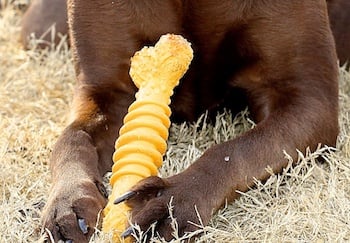 Nylabones or Nylon Chew Toys
Nylabones or Nylon Chew Toys
Like many of the other chews, we’ve discussed already, hard plastic and hard nylon chew toys like Nylabone® can be too hard for your dog’s teeth. These toys have little to no give, and as a result, they have led to many tooth fractures.
If you can't indent the toy with your fingernail, then it's too hard for your dog's teeth.
Making matters worse, a reasonably good chewer can rip off pieces of plastic from a Nylabone and swallow them, leading to a likely digestive obstruction or, at the very least, diarrhea (I learned this before I was a vet!). When pieces of these break off and sit in the stomach, the body keeps trying to break them down. This alone can lead to pancreatitis.
You may have read reports that Nylabones are toxic and can cause seizures. There doesn’t appear to be much merit to these claims. The real danger, as I’ve already mentioned, is damage to your dog’s teeth or digestive system.

Pig Ears
Pig’s ears are another favorite treat among dog owners. While pig ears can provide some solid chew time, they are high in fat.
Foods high in fat can eventually lead to obesity – which creates its own problems for your dog. Additionally, high-fat foods can cause gastrointestinal upset, as well as pancreatitis (which can be fatal for some dogs). This typically results in vomiting, diarrhea, abdominal pain, lethargy, and possibly hospitalization.
Some pig ears, especially those that don’t come from a reputable source, can be coated with harsh chemicals. One such chemical that has been found is bleach. Additionally, some smoked pig ears have been found to have coatings that are carcinogenic.
Pig ears can also harbor or grow all kinds of nasty bacteria (such as salmonella). And, if those drawbacks aren’t enough, pig’s ears can even become a choking hazard or lead to digestive obstructions if your dog is likely to tear off large chunks and swallow them whole.
The unfortunate thing is when they create a blockage, they don’t always show up on an X-ray. which can cause a misdiagnosis, which can delay treatment.
Lastly, while this may not be important to many pet owners, pig ears can leave a greasy residue on your carpet and furniture.
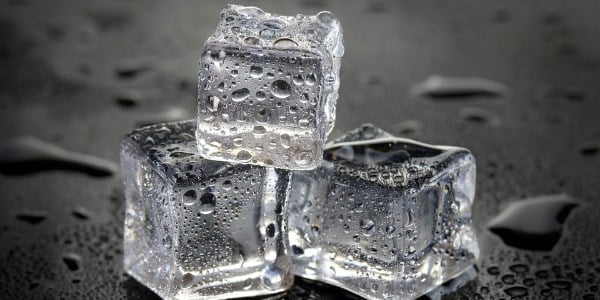
Ice Cubes
While not technically a chew “toy,” plenty of people give their dogs ice cubes to chew on, especially when it's hot or their puppy is teething. Unfortunately, like bones, antlers, hard nylon chew toys, and other hard chews — ice cubes can be hard enough to break your dog’s teeth. They can also be a choking hazard for dogs as well, especially if your dog has damaged or missing teeth.
You may not need to dive onto a fallen ice cube before your dog gets to it, but it’s not the best idea to intentionally give ice cubes to your dog to chew.
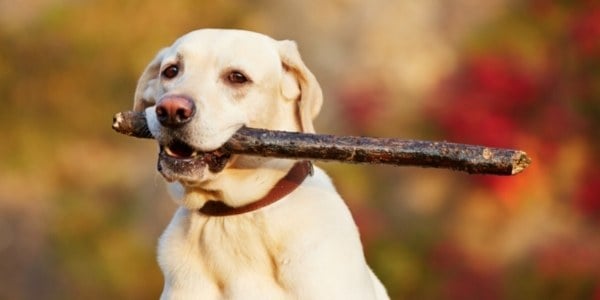
Sticks
While it may seem like a free and readily available chew-and-fetch toy for your dog, sticks can be a quick way to end their good time. They often lead to distressing and devastating puncture wounds of the mouth, eyes, abdomen, and even the heart!
We have covered this topic in many other articles on Preventive Vet, but it bears repeating that sticks are not free toys and are extremely dangerous for dogs.
To best protect your dog's health and safety, as well as your heart and bank account, sticks should never be used for fetch or for chew toys.
I had the sweetest lab as a patient and the owners were just as wonderful. This sweet girl had the bad habit of chewing and eating sticks. One day she was rushed into the clinic but she was unable to be saved.
A necropsy was performed and a hole, created by a stick was found in the intestines. As the stomach contracted to push the stick out, it punctured her small intestines leaving a hole behind. To say the very least, the family was devastated.
Chews to Use With Caution
Bully Sticks
Bully sticks are a favorite recommendation of many dog trainers because they can be extremely helpful during puppy teething phases, as well as high-value enough to entertain destructive chewers.
Veterinarians have varying opinions about whether the potential risks are worth the benefits. As with all dog chews, knowing the risks means you are better informed to make decisions on what you give your dog to chew on.
While bully sticks aren't typically so hard to cause cracked teeth (especially since they get softer as a dog gnaws on them), they are a choking hazard. The bully stick can get lodged at the back of your dog's throat, especially the smaller it gets as they chew.
Some dogs find bully sticks so valuable and delicious that they will try to gulp them down whole. This can cause a gastrointestinal obstruction and can require surgery to remove.
Bully sticks are high-protein chews, and the richness can cause diarrhea. Dogs with kidney issues should not chew on bully sticks as they are usually on protein restriction.
If you decide to use bully sticks with your dog, invest in a bully stick holder. The Bully Grip is a favorite of Preventive Vet's on-staff certified dog trainer.
A holder reduces the risk of your dog swallowing the bully stick whole or swallowing and choking on the stick as it gets chewed to a size small enough to swallow. Make sure the holder you use has a firm grip on the stick – neither you nor your dog should be able to pull or wriggle it out.
Choose high-quality bully sticks (trust me, you'll want the odor-free versions). Used bully sticks can harbor some nasty bacteria, so be sure to throw them away after use. Bully sticks are high in calories and should be used minimally for dogs who are overweight.

Rawhide
Available everywhere and relatively inexpensive, rawhides can be a good chew option for some dogs. Plenty of dogs chew rawhides without incident. However, some dogs end up with bits of rawhide lodged in their windpipe, stomach, or intestines causing a choking or digestive obstruction.
If your dog actually chews the rawhide, rather than biting off and gulping large chunks, they’ll likely be OK (and may even get some teeth-cleaning benefits). If they just bite off chunks, though, or try to swallow it whole, these are definitely not a good chew option for your dog.
If you do use rawhides, avoid those with knots at the end. Those knots, if broken off, can cause serious choking hazards as well as intestinal obstructions. Also, since they can be hard to digest, they are not recommended for pets with a history of gastrointestinal issues or pancreatitis.
You can learn more about choosing rawhides for your dog and what to avoid in our article Safer Rawhide Chews for Dogs.
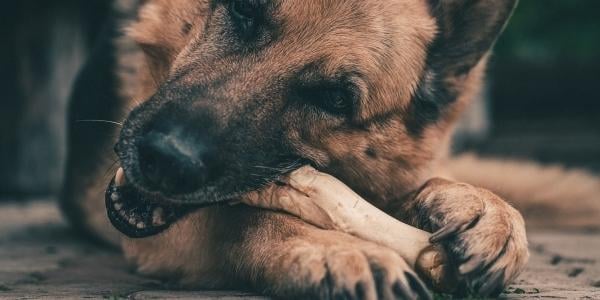
How to Tell if an Edible Chew or Chew Toy is Safe for Your Dog
The chews and chew toys listed above are some of the most popular things you could give your dog to chew on, but as you can see, they can also be quite dangerous. And they’re not the only dangerous chews and chew toys for dogs.
And there are new things for dogs to chew on coming out each day. It can be hard to stay on top of them all!
How to Test Your Dog's Chew for Safety
Put all of your dog’s chews and chew toys through the “tests” below to figure out whether a particular object is likely to be safe for your dog to chew on:
- Hardness: Apply the thumbnail test. If the toy doesn't “give” a little bit when you press it with your thumbnail, then it's likely too hard for your dog and could break their teeth.
- Softness & Durability: The toy also should not be so soft or poorly constructed that your dog will be able to chew it apart and swallow pieces, chunks, or the stuffing inside.
- Coating: It should not be coated or treated with flavorings that can cause digestive upset or support the growth of bacteria both before and during chewing (e.g., the coating on pig’s ears).
- Size & Shape: It should not be so small that your dog could choke on it. Certain shapes make it easy for your dog to get their tongue or muzzle stuck in it, such as circles or rings. It also shouldn’t be too big for them that they could strain or otherwise injure their jaw working on it.
This can get a bit difficult in homes with multiple dogs of varying sizes, but it’s important to pay attention to the size of the toys that you’re bringing into your home as they relate to the different-sized dogs you may have. - Washability: Ideally, you should be able to put it in the dishwasher or washing machine and clothes dryer to be periodically cleaned and disinfected.
- Entertainment Value: It should be able to provide hours of chewing entertainment and distraction, either because it will last a long time, you are able to stuff it with treats/food, or your dog just really enjoys playing with it.
- Your Dog's Chewing Style: Each dog has their own "chewsonality." Some are inhalers and/or destroyers, while others just like to nibble. Knowing your dog’s chew style aids in selecting the best chew.
Learn how to determine what type of chewer your dog is (and get recommendations for the best chew toys) in How to Choose Safe Dog Chews.
Preventive Vet’s Picks for Safer Dog Chews
It’s confession time: Much of the Preventive Vet team is guilty of spoiling our dogs. We’re slightly ashamed to admit how much of our usable space is devoted to storing our dogs’ favorite toys, nummies, and other embarrassing euphemisms.
The good news is that this experience has given us plenty of food for thought when it comes to recommending toys based on our evaluation of safety, durability, and overall quality. Here are some of our dogs’ faves that we think yours will love as well.
Please note that while these chews and "stuffable" toys are safer and more durable, you must still take precautions.
- Always inspect all chews for damage or wear before giving them to your dog.
- Do not leave these toys out in the sun or extreme temperatures. It can degrade them faster and weaken them. While they may look ok, they are not as structurally strong.
- Check your dog’s teeth for any wear, chips, or fractures.
- Supervise your dog while they are playing and chewing with toys. If they get too riled up or are chewing too aggressively, have them take a break from chewing. This may help prevent a tooth fracture or them breaking off a large piece and either choking or getting an obstruction.
- Consider a chewing schedule. Even the safer toys mentioned can cause some irritation to your dog’s gums, and giving them a break may be beneficial. Also, if you are adding treats to toys, such as the Kong, you need to watch how many extra calories your dog may be getting.
- Be sure to regularly clean the toys.
Our Favorite Chews and Interactive Toys for Dogs
The Toppl
West Paw has a fantastic selection of non-toxic, durable toys that dogs love. They’re dishwasher safe as well. The Toppl is the all-time favorite of Preventive Vet's certified dog trainer when it comes to food puzzles.
In fact, it's the main toy she uses to feed her dogs their regular meals. With a larger opening than the Kong, it's ideal for puppies learning how to de-stuff a puzzle toy or for adult dogs who get frustrated with the difficulty of a frozen Kong.
To increase the difficulty level and extend the time your dog will play with (and be distracted by) their stuffed toy, you can freeze the toy after stuffing.
One thing to keep in mind with the Toppl is that it is graded for "medium" chewers. A determined and strong-jawed pup may be able to chew it into pieces if left unsupervised.
Check out this video of Preventive Vet's certified trainer Cathy Madson’s puppy, Fozzie Bear, working on his stuffed and frozen Toppl in his crate.
The Qwizl
The West Paw Qwizl is ideal for inserting treats, so it takes longer for your dog to finish the treat and engages your dog's brain. Because of the long shape and hollow core, the Qwizl can also take a bully stick (if your dog plays with them safely), and healthy apple slices or carrots.
Check out Preventive Vet's favorite Welsh Cardigan Corgi – Sookie getting her treat on below!
What can you stuff your dog's Qwizl or Toppl with? All kinds of treats fit in the Toppl. What you stuff it with depends on your dog and the specific size of Qwizl or Toppl you get, as well as the size of the treat.
Some popular ideas include your dog's kibble and/or wet food, peanut butter, and even your dog's regular dog treats. Feeling adventurous? Check out more Toppl stuffing recipes here.
KONG Toys
Kong makes a variety of highly popular rubber chew toys and interactive feeders. They state that their products "undergo rigorous testing... by independent laboratories," which is part of the reason that Kong is one of our top picks for non-toxic dog toys.
The Classic Kong can be filled with dry or wet food, and there are plenty of other "stuffing" recipe ideas on the Kong website. You can also freeze the toys with food inside to make them last longer and extend your dog's fun.
While they are a safer option, Kongs can still be destroyed and your dog can break off pieces. These large pieces can cause potential choking hazards and intestinal obstructions.
Always inspect these toys prior to use and monitor your dog while they are playing with them.
There are four different types of Kongs, with different strengths of rubber based on your dog's chewing strength and dental health.
- The KONG Classic is able to withstand moderate chewing.
- Designed for the toughest of chewers, the KONG Extreme is made for more intense chewing and stronger jaw strength.
- The Senior KONG is designed to provide a gentle and comfortable chewing outlet for senior dogs with more sensitive teeth and gums.
- The Puppy KONG dog toy is customized for a growing puppy's baby teeth, the unique, all-natural rubber formula is the most gentle within the KONG rubber toy line.
Size Matters
An important warning about choosing the correct size toys for your dogs, including when you have multiple dogs of different sizes. This photo is an X-ray of a dog’s abdomen.
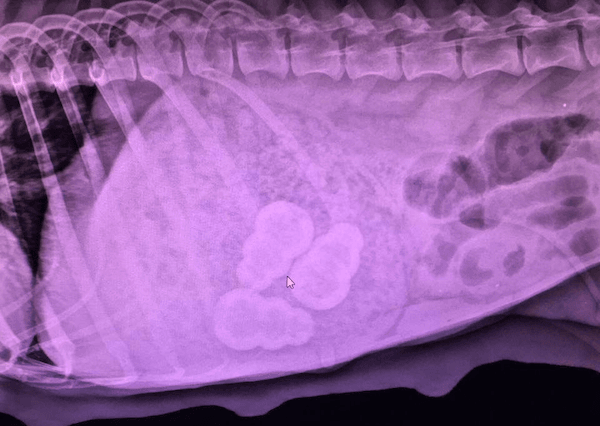
Photo credit: Dr. Mandy Roberts, Hoschton Animal Hospital
The three snowman-shaped objects you see in the middle of the image are Kongs within the dog’s stomach! They wound up there, not because the dog’s owner intentionally gave their dog the wrong-sized Kongs, but rather because their child didn't supervise closely enough while this dog’s puppies were playing with their food-stuffed Kongs!
Mom perhaps decided that her pups were having too much fun and wanted in on the action. Or, maybe it was as it so often is, the kids just left their mess lying around for mom to clean up … and clean up this mom did!
She had to be taken to surgery to have these three Kong toys removed from her stomach. She came out unscathed, but the cost of surgery was an unfortunate consequence for the family.
Rawhide Alternatives
I have given my small dog the Wild Eats Water Buffalo Cheek Chips as a rawhide alternative. Their size makes them perfect for small dogs, but I wouldn't advise for larger dogs due to choking hazards.
Another team favorite at Preventive Vet for a rawhide alternative is the Earth Animal No-Hide Chews. They come in a variety of sizes, making it easier to find one that is at lower risk of being a choking hazard for your dog. The ingredients used also make them more digestible than traditional rawhide.
Dental Chews
Virbac C.E.T. Enzymatic Oral Hygiene Chews contain no artificial coloring and are made from carefully selected hides. These chews also include a powerful and beneficial enzyme called glucose oxidase, which helps protect your dog's teeth by breaking down the sugars that disease-causing bacteria feed on. You can buy them online or get them from your veterinarian.
I think when it comes to our pets, we all have different thoughts on what they should be fed, what treats they should get, how much they should weigh, etc.
Additionally, each pet is unique, and what works for one dog of a particular size or breed may not work for another. Each dog is an individual living in their own environment. You know your dog the best and what works best for them (and you).
The reason there are ‘warning labels’ on merchandise is that companies want to share others’ bad experiences to help someone avoid the same potential harm.
While we may never agree on this or that, it never hurts anyone to listen to others and be open-minded. You never know when new knowledge will help you or someone else.
Sharing our personal and professional experiences can help others learn new things (hopefully in a protective way) and provide a different perspective.
I believe this concept is why people share tips when working on projects or cooking to help others avoid the pitfalls they experienced so that someone else can just feel the goodness of what they are doing.
For more of our favorite dog chews and chew toys, check out our list of The Best Dog Chews and Toys. Feel free to ask a question and share your favorite chews and your stories below, so we can all benefit from each other’s experiences.




